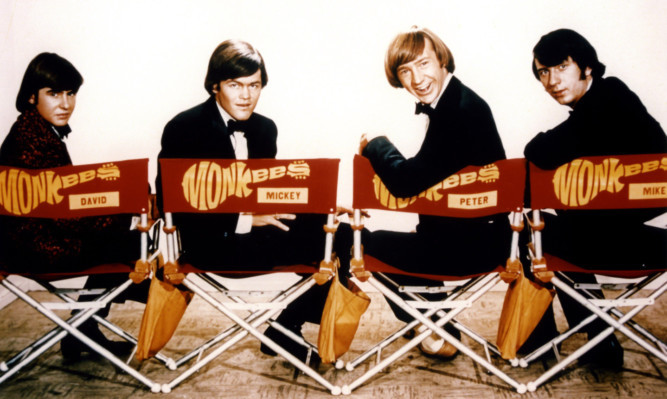
THEY were the greatest Beatles tribute act who ever lived and even the Fab Four loved them.
A quartet of actor-singers, they barely knew each other when, boyband-style, they were brought together to become an instant group in 1965.
It was all with the idea of a TV series in mind, but The Monkees would outgrow such humble beginnings.
Micky Dolenz, the ever-grinning one who played drums and sang, said that the show, simply called The Monkees, was “about an imaginary band that wanted to be The Beatles, but was never successful”.
Well, the real band became so successful, they at one time kept the Fabs and the Stones off the top of the charts, and became bosom buddies with the biggest music stars around.
Michael Nesmith, in contrast to Dolenz, was the never-grinning one, always pictured with a poker face and woolly hats on his head.
He, however, brought a lot of the real talent to the band and, after the split, he would forge a respectable solo career, and tours to this day.
Davy Jones was the McCartney of the set-up, the cherub-featured singer who brought the teen girl fans in their millions, and Peter Tork was the slightly-goofy one, all long blond hair and energy.
It was the Beatles’ movie A Hard Day’s Night that inspired the original idea a gang of talented, likeable lads, getting up to lots of harmless mischief and generally having endless gangs of hysterical young ladies trying to track them down.
Jones even had an accent to help, being originally from Manchester, but the other boys were all American.
Funny, then, to think Nesmith went crazy when he first set eyes and ears on their debut LP.
Much of the music had been played by studio session musicians, not the lads themselves, and he admitted: “I went completely ballistic. It made us appear like a rock ’n’ roll band.
“There was no credit for the other musicians! The TV show was about a rock ’n’ roll band, but we were not a real rock ’n’ roll band!”
That album was released as a soundtrack to the TV series, of course, but someone had decided that he’d have it look as if The Monkees really were a band and had played it all.
True, they did add bits and pieces of the music, and definitely the singing, but they now wanted to live out for real what they had been acting, and it worked.
Last Train To Clarksville was a massive hit, and even today’s kids love it you can hear the Beatles influence all over it, but it did have a sound of its own, too.
They could certainly sing, and they knew how to make jangly guitars and tambourines sound like the most exciting thing in the charts, even more exciting than some of the stuff those Moptops were coming out with.
Nesmith would become a close pal of John Lennon, and recalled the Beatles’ co-leader’s attitude towards these young upstarts from America.
Having asked Lennon if he felt The Monkees were just a cheap imitation of The Beatles, John replied: “I think you’re the greatest comic talent since the Marx Brothers, and I’ve never missed one of your programmes.”
Ouch!
If jokey asides like this rankled with Nesmith, who was a serious musician, for Jones, the worst time was when the British press turned on his group.
Some people had felt conned to learn outside musicians sometimes played on the records, despite the fact the lads themselves had happily admitted it.
“I get so angry when musicians say: ‘Oh, your music is so bad,’” Davy admitted.
“It’s not bad to the kids! Those people who talk about ‘doing their own thing’ are groups that go and play to 50 people, while we’re playing to 10,000 kids.”
It was a fair point.
As any Monkees fanatic will tell you, the cynics should remember this in those first few years, they spent 12 hours a day recording music and filming the TV series.
When they weren’t doing that, they were touring and between gigs, they were learning to play instruments!
Now, tell that to anyone who has sung their way to stardom on today’s talent shows.

Enjoy the convenience of having The Sunday Post delivered as a digital ePaper straight to your smartphone, tablet or computer.
Subscribe for only £5.49 a month and enjoy all the benefits of the printed paper as a digital replica.
Subscribe